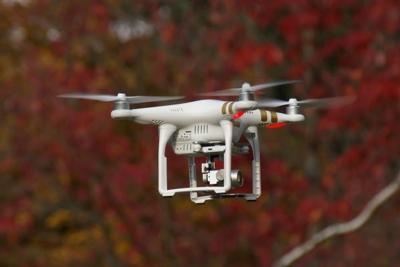Thu, Oct 17, 2019
Cites Information Presented By BALPA, Others
A report released by the U.K. House of Commons Science and Technology Committee indicates that helicopters are the manned aircraft at the greatest risk from consumer drones.

Helicopter Investor reports that the report cites information presented by a specialist from BALPA, who said that helicopters are "supremely susceptible to catastrophic damage" from a drone strike, particularly impacts to the windscreen and rotors. The BALPA representative also said that helicopters more often fly over dense urban areas where there is little margin for error, and helicopters are more likely to fly in areas where drones might also be present, such as traffic and police incidents.
Babcock International, one of the U.K.'s largest air ambulance operators, has called for temporary flight restriction zones around helicopter landing sites, including ad-hoc LZs. A representative from Babcock and Capt. Tim Pottage, Communications & External Relations Sub-Committee Chairman, said an exclusion zone of one kilometer (0.6 mile) should be required unless coordinated with the helicopter pilot.
“The Government should introduce temporary drone flight restriction zones around helicopter landing zones. The Government should publish findings from a review on this and legislate accordingly within the next twelve months,” the report concluded.
Concerning commercial airliners, the report cites a U.K. CAA analysis which indicates that "It is considered unlikely that a small drone would cause significant damage to a modern turbo-fan jet engine; even if it did, a multi-engine aircraft would still be likely to be able to land safely. The likelihood of a small drone being in proximity of a passenger aircraft when it is travelling fast enough to potentially damage its windscreen is currently about two per million flights. And; the likelihood of a small drone hitting a passenger aircraft windscreen at sufficient speed to rupture it is much smaller than the probability of it being in the proximity of an aircraft."
However, Capt. Pottage said he was "concerned" that the CAA held that view. "There has been no testing of a drone against a large commercial high bypass jet engine—none at all. Anecdotal evidence suggests that it would cause a catastrophic failure, causing a blade to shed and not to be contained within the engine cell," he said.
(Image from file)
More News
Mid-Continent Instruments and Avionics and True Blue Power ANN's NBAA 2025 Coverage... Visit Them At Booth #3436 True Blue Power Introduces New 45-watt Charging Ports for 14- and 2>[...]
En Route Automation System (EAS) The complex integrated environment consisting of situation display systems, surveillance systems and flight data processing, remote devices, decisi>[...]
“Our Kodiak aircraft family is uniquely designed to meet the rigorous demands of such deployments, bringing short takeoff and landing performance, robust cargo capacity and e>[...]
Aero Linx: Australian Society of Air Safety Investigators (ASASI) The Australian Society of Air Safety Investigators (ASASI) was formed in 1978 after an inaugural meeting held in M>[...]
Left Main Landing Gear Struck A Bush, And The Right Wingtip Impacted The Ground Analysis: According to the pilot of the tailwheel-equipped airplane, he noticed that the engine oil >[...]
 True Blue Power and Mid-Continent Instruments and Avionics Power NBAA25 Coverage
True Blue Power and Mid-Continent Instruments and Avionics Power NBAA25 Coverage ANN's Daily Aero-Term (10.15.25): En Route Automation System (EAS)
ANN's Daily Aero-Term (10.15.25): En Route Automation System (EAS) Aero-News: Quote of the Day (10.15.25)
Aero-News: Quote of the Day (10.15.25) ANN's Daily Aero-Linx (10.15.25)
ANN's Daily Aero-Linx (10.15.25) NTSB Final Report: Jeremy S Lezin Just SuperSTOL
NTSB Final Report: Jeremy S Lezin Just SuperSTOL



